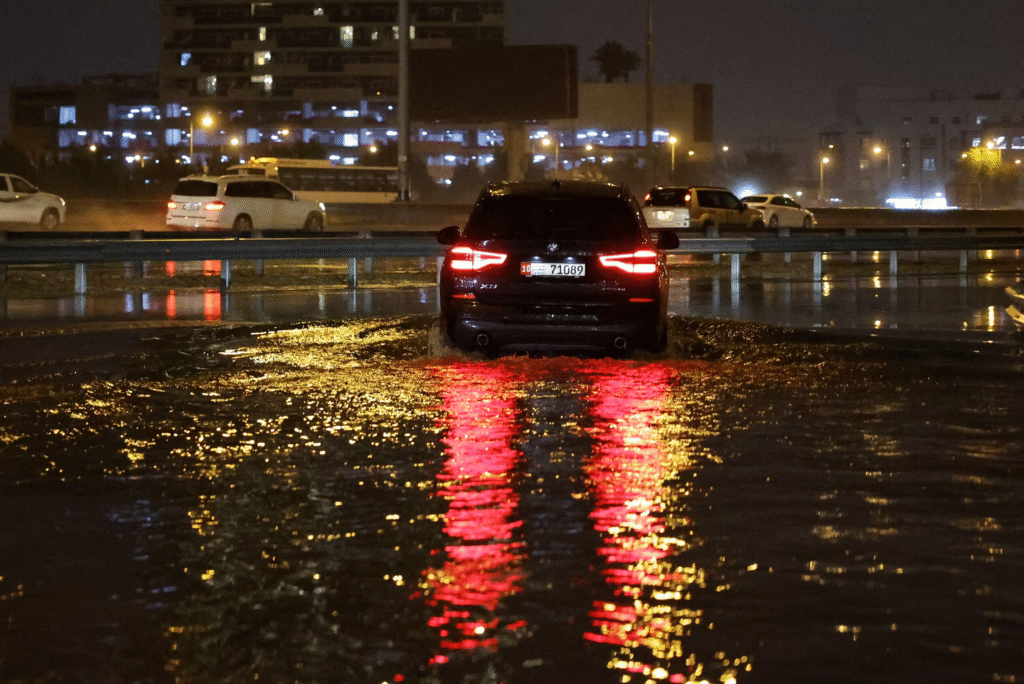
Dubai witnessed a rare and powerful storm this week, bringing heavy rain, thunder, and strong winds that disrupted daily life in the city known for its sunshine and calm weather. The unexpected downpour led to waterlogged roads, delayed flights, traffic congestion, and warnings issued by government agencies.
This unusual weather pattern left many residents and tourists shocked, as Dubai usually enjoys hot and dry desert conditions during this time of year. The authorities have urged caution and shared important updates to help people stay safe and informed.

The storm started late Monday night and continued into Tuesday morning with strong winds, loud thunderclaps, and lightning strikes lighting up the sky. Some areas of Dubai received more than 50 mm of rainfall within just a few hours — an amount rarely seen in the emirate.
Videos and images flooded social media, showing cars submerged in water, flooded parking lots, and overflowing drainage systems struggling to handle the sudden downpour. The storm’s unexpected intensity forced many to stay indoors or delay travel plans.
Dubai’s Road and Transport Authority (RTA) warned drivers to avoid flooded areas and drive slowly as waterlogging caused massive traffic jams on Sheikh Zayed Road, Al Khail Road, and other main highways.
Dubai International Airport (DXB), one of the busiest airports in the world, reported flight delays and diversions due to poor visibility and water accumulation on runways. Several inbound flights were redirected to neighboring airports such as Abu Dhabi and Sharjah.
In an official update, Emirates Airlines and flydubai advised passengers to check their flight status before leaving home, as delays and cancellations were expected to continue until weather conditions improved.
Many schools in Dubai declared emergency closures to ensure the safety of students and staff. Events, including outdoor exhibitions, concerts, and desert safari tours, were cancelled or postponed.
Dubai Police and Civil Defense teams responded quickly to dozens of calls from stranded motorists and residents needing help in flooded buildings and underground parking areas. Emergency services worked overnight to pump out water from low-lying zones and clear blocked drainage systems.
A few minor accidents were reported, but no major injuries or casualties have been officially confirmed by the authorities so far.
The National Centre of Meteorology (NCM) issued a red alert, warning residents to expect more rain showers and strong winds in the coming hours. People were urged to stay home unless absolutely necessary and avoid going near beaches, wadis, or open water bodies, where sudden flooding could pose serious risks.
Dubai Municipality teams were deployed across the city to clean streets, clear fallen trees, and fix damaged infrastructure. Temporary pumping stations were installed in flooded areas to remove water quickly and restore traffic flow.
In addition, health and safety advisories were issued reminding residents to:
The storm also affected Dubai’s business hubs such as Downtown Dubai, Business Bay, and Jumeirah Lake Towers (JLT), where some offices reported temporary closures or a shift to remote working due to flooding around buildings.
Supermarkets and grocery delivery services faced delays, while restaurants saw a drop in foot traffic. E-commerce companies warned customers of late deliveries as courier services were disrupted.
Despite the inconvenience, many Dubai residents shared videos of the rare rainfall, calling the city’s brief transformation into a “water city” both beautiful and surreal.
Weather experts from the NCM explained that this storm was caused by an unusual low-pressure system in the Arabian Peninsula, which led to cloud formation and heavy rainfall.
They also pointed out that climate change could make such rare events more frequent in the future, even in typically dry regions like the UAE.
A senior meteorologist said:
“The Gulf countries, including the UAE, are seeing changes in weather patterns. While storms like this remain rare, the risk is higher due to rising global temperatures and atmospheric shifts.”

According to the NCM, weather conditions are expected to gradually improve by Wednesday afternoon, with clouds clearing and temperatures returning to their usual highs of 38°C to 42°C.
However, authorities warned that puddles, slippery roads, and fallen debris could still cause hazards in some areas. Clean-up and repair work are expected to continue for the next few days.
To stay safe and updated during the Dubai storm situation:
While Dubai is no stranger to high temperatures and desert heat, this week’s storm has shown how unpredictable weather can be. The city’s quick response has minimized serious damage, but residents and visitors are reminded to remain cautious until the situation fully stabilizes.
Stay tuned for more updates as authorities work hard to return life in Dubai to normal.
Read More:- Portugal’s Dama Art Gallery Takes Global Lead in Art Movement Now 2025
